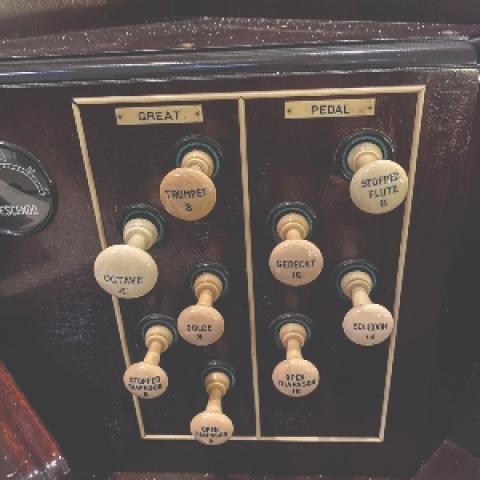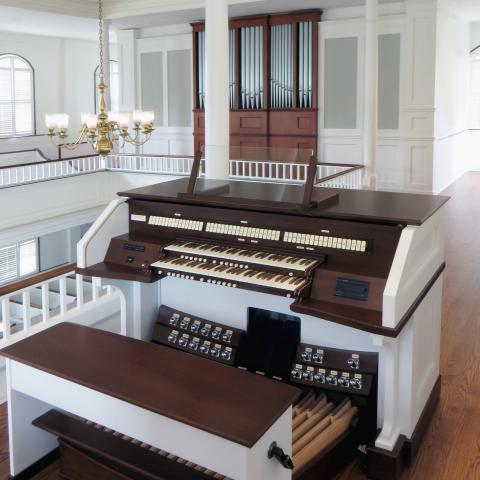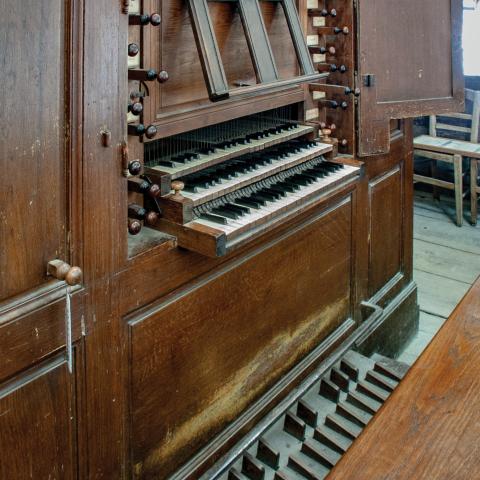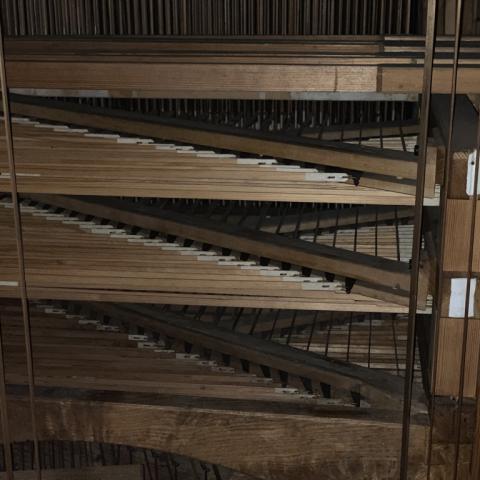
Ringing through the night
Wendy and I left our apartment in Greenwich Village in March of 2020, fleeing from the burgeoning epidemic to the relative safety of our home in Maine. Although the current second wave with choices of variants is ravaging the unvaccinated population there now, through the summer of 2020 Maine was one of the least affected states in the early stages of the epidemic with cases counted on your fingers compared to the tens of thousands each day in New York City. We ventured back into New York after sixteen months, gingerly returning to the life we have loved there. Finding our neighborhood transformed with outdoor dining consuming parking spaces and congesting sidewalks, we decided to leave the city. We had a ten-year run there, and we are the richer for it.
With our place in Maine as a comforting constant, we have moved to Stockbridge, Massachusetts, in the Berkshire Mountains, barely five miles from Tanglewood, the summer home of the Boston Symphony Orchestra. We are living four tenths of a mile from Saint Paul’s Episcopal Church (across from the Red Lion Inn), where my grandfather was rector during my pre-teen and teenage years and where I practiced endlessly on the Roosevelt organ, sadly “baroque-ified” so that much of the original grandeur is gone—but as a thirteen-year-old, I thought it was wonderful.
Our house is about 600 feet from the Children’s Chime Tower, a lovely structure on a picturesque village common, with eleven bells, the largest of which tolls every hour. We can hear it from our bedroom, so we give each other morning reports of which hours we heard. My tuner’s ear gets mired in identifying the overtones, an arcane version of counting sheep, and I have found myself thinking anew about the role of overtones in tonal music and the development of the pipe organ.
How do you make an organ stop?
In February 2017, I gave a lecture titled “Pythagoras, broccoli, and the development of pipe organ stop action” for the Presidents’ Day Conference of the New York City Chapter of the American Guild of Organists. I was inspired to lecture on this when a family member casually asked why the voices of the organ are called stops? Wouldn’t it make sense to call them “go’s?” After all, we pull out stops to make an organ go.
Pythagoras lived on the Greek island of Samos in the eastern Aegean Sea, barely a mile from Turkey. It is near the popular resort islands of Naxos and Mykonos and about 170 miles south of Lesbos, also close to the Turkish coast, which has been central to the continuing refugee crisis in the region. Pythagoras (c. 570–495 BC) was a mathematician who famously gave us the eponymous theory defining the length of the hypotenuse of a right triangle (A2 + B2 = C2) and who discovered the series of overtones present in any musical note. Walking past a blacksmith shop, Pythagoras noticed that the workers produced different pitches as they hammered on their anvils and thought at first that it was the size of the hammer that affected the pitch. It did not take much experimentation to determine that it was the size of the anvil. Our tower bell is a good example. You get the same pitch if you hit the bell with a pencil or a hammer.
Organists know the overtone series by the pitches of our stops. Unison pitch is 8′. The first overtone is an octave higher (4′), the second is an octave and a fifth (2-2⁄3′), the third is two octaves higher (2′), the fourth is two octaves and a third (1-3⁄5′), the fifth is two octaves and a fifth (1-1⁄3′), then 1-1⁄7′, 1′, etc., ad infinitum. Organ stops rarely go higher than 1′, although we often find pitches like 1⁄2′, 1⁄3′, 1⁄4′ in the lower octaves of high-pitched compound stops like Cymbals and Scharffs.
We start with the earliest forms of pipe organs such as the hydraulis, created by Ctesibius of Alexandria in the third century BC, which had a pressurized wind supply regulated by the weight of water, a row of primitive organ pipes, and a keyboard-like mechanism for the choosing of notes. That instrument and many of the following stages of evolution had a single set of unison pipes. As those organ builders began to understand their sophisticated musical tones and became aware of the overtones, it was natural to add a set of pipes that spoke at the first overtone, an octave higher, to brighten the tone. Then, perhaps, a second rank of unison pipes was added to beef things up, then another four-footer. Imagine the light bulb over the guy’s head when he thought of adding a rank at the second overtone, the world’s first Nazard.
This primitive organ came to include a dozen or more ranks and was known as a “Blockwerk.” There was no stop action, just a big powerful chorus of voices bellowing simultaneously, so the next innovation was to separate the windchest into two parts, with the original unison rank on one wind supply, and the rest of the multitude on the other whose wind could be shut off by a separate control. When I was writing my lecture, I conferred with several colleagues well versed in organs of the fourteenth and fifteenth centuries and learned that the original name for that control was “doof,” an old Dutch word that meant either “dumb” (as in deaf and dumb) or stupid. One Dutch colleague told me that “doof” was the nickname her grandmother had for her grandfather, and her family assumed that she was intending both definitions. In modern English, the first pipe organ stop action was intended to turn things off. Stop.
That led to family discussions on the original question. We “pull out all the stops” to make a loud noise on an organ or to give a situation or task our best shot. “This year when spring cleaning we’re going to pull out all the stops.” We pull out a stopper to make liquid flow, like wine from a bottle, and conversely, we use a doorstop to keep a door open.
Use your ears.
The common registrations for French Classic organ music give us some of the clearest examples of exploiting the overtones of each stop. Think of the Cornet decomposé, literally a dismantled five-rank Cornet with flutes at 8′, 4′, 2-2⁄3′, 2′, and 1-3⁄5′. Each has its own rich overtone structure, but collectively, they mimic the harmonic structure of the reeds like Trompette or Cromorne. The Trompette ranks in French Classic organs had broad scales and powerful tones from the bass, through the tenor, and into the middle octave of the keyboard before they started to peter out toward the treble. The five-rank Cornet starts at middle C and is intended to beef up the treble of the reeds, and you can imagine where Clérambault got the “Basse et Dessus de Trompette” and Balbastre and d’Aquin the rollicking pairings of Cromornes and Cornets in their noël variations.
The Cornet decomposé allows the fascinating variety of combining two, three, or four of those pitches to achieve different sonorities, and those ranks can be added individually or in combinations to the Cromorne, Hautbois, or Trompette to spice things up, like adding a dash of cayenne to an otherwise stolid dish.
When I was an apprentice in Ohio in the mid 1970s, my mentor John Leek and I went to tune a large M. P. Möller organ for the first time. It was a neo-Baroque rebuild of an earlier Möller that had an impossible Positiv division with a chiffy Gedackt, a smarmy 4′ flute, and a terribly high-pitched Cymbal, the kind that at first glance looks like there are only six different sized pipes making up the sixty-one notes of three ranks. What do you use to tune that squealing thing? There was a yellowed index card lying on the tuning perch with a neat suggestion: tune the Krummhorn to the Great 4′ Octave, far away but still easy to hear, and tune the Cymbal to the Krummhorn, being sure that each note of the Krummhorn is still in tune. The infinitely high overtones of the Krummhorn pipes clearly matched the stratospheric pitches of the pencil-sized pipes.
I use that technique to this day when tuning higher-pitched mutations. The top octaves of the Tierce ring out clear as a bell against an Oboe or Trumpet because those partials are so strong in the reed pipes. Any tuner’s ears are trained to hear those overtones in single pipes. You can learn this by playing a note in an Oboe (the tenor octave is usually the clearest) and turning a 2-2⁄3′ stop on and off, or by playing a fifth above in a different stop. Reinforcing the second partial that way helps your ear pick up the partial in the reed pipe alone. I love that demonstration as an important lesson about how musical tones work.
Thicken the batter
When you combine stops that speak in intervals with one another, you build a sassy pile of dissonance. Imagine playing C with an 8′ stop whose second partial (overtone) is G, an octave and a half above. Add the 2-2⁄3′, which speaks a G, with a second partial of D. Add the 1-3⁄5′, whose second partial is B. With those three pitches playing, you are hearing a cluster of several C’s, G’s, D’s, E’s, and B’s all at once. When you add another layer of partials it becomes a twelve-tone cluster. This conglomeration helps explain why mutations can be so difficult to tune. Consider a mixture tuned in equal temperament and play C. The ranks of a usual mixture are speaking octaves and quints (C’s and G’s). The ranks of the mixture are tuned pure to each other, but the intervals on the keyboard are tempered so you are hearing both tempered and pure fifths when you play chords. This is true to some degree in any unequal temperament because it is impossible to temper every interval pure. It may seem as though I am describing unbearable dissonance, but in fact, it is a richness comparable to twenty violins playing in unison in a great orchestra. It is impossible for them all to play identical pitches, but they are close enough to each other that we hear it as three-dimensional richness.
A palette of color
Looking at the rows of pipes inside an organ, you can see a variety of shapes and sizes and a variety of materials used to make them. We refer to the differing diameters of pipes of the same length as “scaling.” An 8′ pipe with a large diameter (diapason) produces a broad tone, while one of narrow scale (string) produces a keen tone. Broad scales and softer material like wood or metal with higher lead content emphasize the fundamental pitch. Harder metal (high tin content) emphasizes the development of higher partials and produces brighter tone. That is a simple description of the rich, earthy tone of a Skinner diapason as compared with the brightness of principal pipes in an organ by Rieger or Beckerath.
Various shapes of resonators like the “choo-choo-train” tops of English Horn pipes or the narrow brass tubes leading to cylindrical resonators of a Schalmei affect the harmonic development of tone and create different timbers. A Clarinet has a cylindrical resonator like a Cromorne. Adding a bell at the top of a Clarinet pipe enforces the fundamental, adding the richness to create a Corno di Bassetto. A “usual” Oboe has a double taper, a long, narrow taper that opens to more of a flare at the top. An Orchestral Oboe has a very thin scale and a gradual taper. A Tuba and a Trumpet are more or less the same in production of tone, but the Tuba has a larger scale and usually higher wind pressure. The placement of scrolls for tuning and regulating also affects the timbre of a pipe.
Similarly, some flue pipes have particular shapes that define the tone. A Rohrflöte is usually a capped metal pipe with a chimney soldered to a hole in the cap. I imagine that the hole in the cap frees the quint, as the presence of a stronger second partial creates the signature brightness of that flute. Ernest M. Skinner and others often made Rohrflötes (also called Chimney Flutes) of wood, drilling through the handle of the stopper to create the chimney. The tapered cap with a small opening at the top of a Koppelflöte pipe has a similar effect.
A tapered flue pipe like a Spitz Flute or Gemshorn, wide scale at the mouth and narrow scale at the top, is a hybrid. The wide scale allows a wide mouth that creates greater tone, but the narrow scale at the top points it toward a string. Many mid-century Aeolian-Skinner organs, especially in the Joseph Whiteford years, have gently tapered principal pipes. A colleague once joked while pointing out Whiteford’s house near the Charles River in Boston, “It’s the one with the tapered doorway.”
All these variations give us the rich palette of tone colors in our pipe organs, and it all relates to the manipulation of the overtone series. Pythagoras may not have foreseen the comparison of a Gedackt and a Chimney Flute, but he discovered and described the math that makes it possible.
So why the broccoli?
The title of my lecture was “Pythagoras, broccoli, and the development of pipe organ stop action.” A thirteenth-century Italian mathematician named Fibonacci discovered a series of numbers that is found throughout nature. The infinite Fibonacci series starts 1 + 1 = 2, 1 + 2 = 3, 2 + 3 = 5, 3 + 5 = 8, etc. Each successive number is the sum of the preceding two. This series defines the spiral of a nautilus shell, the diminishing tiles of a pineapple or pinecone, and yes, the diminishing spirals of Romanesco broccoli. It also defines the diminishing intervals between musical overtones. Pythagoras had the numbers right 1,800 years before the Fibonacci series was identified.
Nunc dimittis
Friend and colleague Richard Houghten of Ann Arbor, Michigan, passed away on December 29, 2021. Dick was the American presence of Solid State Organ Systems (SSOS, formerly SSL), which has been producing excellent control systems for pipe organs for more than a generation. He had also served as the American representative for Laukhuff, helping dozens of us choose what products we needed and helping us with the complications of ordering products internationally.
He installed SSOS systems in dozens of America’s greatest organs and was available as mentor and guide, helping many of us find our way out of technical problems. I spoke with him, asking for advice about a complicated organ while he was recuperating from surgery coupled with complications, and though he was confined and suffering, he was eager to help, answering my questions and providing follow-up information.
His skills, wisdom, and thoughtful presence added much to the world of organ builders, and I am grateful to have known him as a colleague and a friend. He cared deeply about the organ classes at the neighboring University of Michigan, inviting them to his home and workshop and sharing his experiences with them. Above everything, Dick was a gentleman in every sense of the word. I miss him, and I will remember him always.







